|
Battle of Piedmont, Virginia, History
Other Names: None
Location: Augusta County
Campaign: Lynchburg Campaign (May-June 1864); Shenandoah Valley Campaigns of 1864
Date(s): June 5-6, 1864
Principal Commanders: Maj. Gen. David Hunter [US]; Brig. Gen.
William E. Jones [CS]
Forces Engaged: 14,000 total (US 8,500; CS 5,500)
Estimated Casualties: 2,375 total (US 875; CS 1500)
Result(s): Union victory
| Battle of Piedmont |
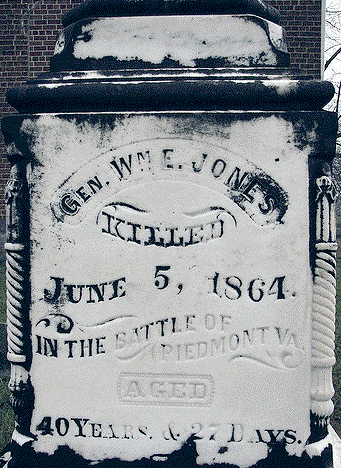
|
| Civil War Battle of Piedmont, Virginia |
| Battle of Piedmont |
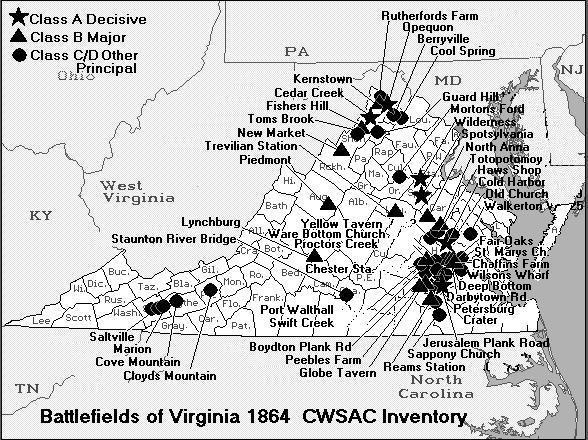
|
| Civil War Piedmont Battlefield Map |
Description: After replacing Sigel in command of Union forces
in the Shenandoah Valley, Maj. Gen. David “Black Dave” Hunter renewed the Union offensive. On June 5, Hunter engaged
the Confederate army under “Grumble” Jones north of Piedmont. After severe fighting, a flanking movement made
by Thoburn’s brigade turned Jones’s right flank. While trying to stem the retreat of his soldiers, Brig. Gen.
William E. "Grumble" Jones was killed. The retreat became a rout. More than 1,000 Confederates, including 60 officers, were
captured. Jones lost three guns. Hunter occupied Staunton on June 6 and, after a pause to await the arrival of Brig. Gen.
George Crook’s column, began to advance on Lynchburg, destroying military stores and public property in his
wake.
During the battle, Commanding General William E. "Grumble" Jones had shouted
to Love's fighting infantry, "Brave Carolinians I will bring you help!" He soon
returned with the Thirty-sixth and Sixtieth Virginia Regiments, but it was too late. While pressing his horse across the smoked
filled battlefield rallying and encouraging the Highlanders and Virginians, Jones was shot in the head and his lifeless body slumped
and fell to the ground. (Official Records of the Union and Confederate Armies, Series 1, Volume 37, part 1, page
606; O.R., 37, 1, pp. 94-95; and O.R., 37, 1, pp. 150-151).
| Battle of Piedmont Map |
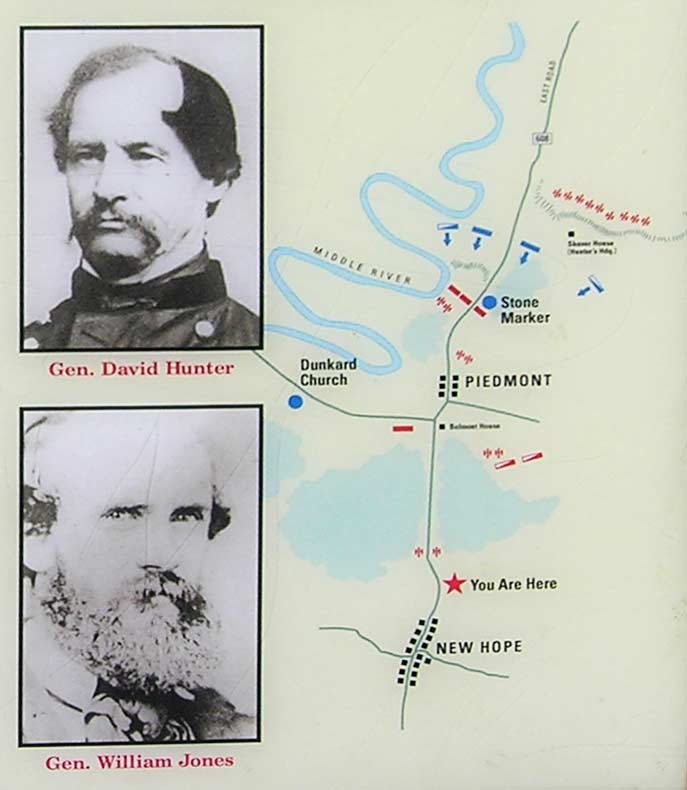
|
| Battle of Piedmont Civil War Battlefield Map |
Background: At the beginning of 1864, Union Maj.
Gen. Ulysses S. Grant was promoted to lieutenant general and given command of all Union armies. He chose to make his headquarters
with the Army of the Potomac, although Maj. Gen. George G. Meade remained the actual commander of that army. He left Maj.
Gen. William Tecumseh Sherman in command of most of the western armies. Grant understood the concept of total war and believed,
along with Sherman and President Abraham Lincoln, that only the utter defeat of Confederate forces and their economic base
would bring an end to the war. Therefore, scorched earth tactics would be required in some important theaters. He devised
a coordinated strategy that would strike at the heart of the Confederacy from multiple directions: Grant, Meade, and Maj.
Gen. Benjamin Butler against Robert E. Lee's Army of Northern Virginia near Richmond; Maj. Gen. Franz Sigel to invade the
Shenandoah Valley and destroy Lee's supply lines; Sherman to invade Georgia and capture Atlanta; Maj. Gen. Nathaniel Banks
to capture Mobile, Alabama.
The Battle of Piedmont was one of many battles fought during
the Lynchburg Campaign. The Lynchburg Campaign, also known as Hunter's Lynchburg Campaign, was part of the Shenandoah
Valley Campaigns of 1864 and was the first of three principal campaigns fought throughout the valley region.
Lynchburg Campaign [May-June 1864] consisted of the following battles:
New Market – Piedmont – Lynchburg.
| Battle of Piedmont Map |
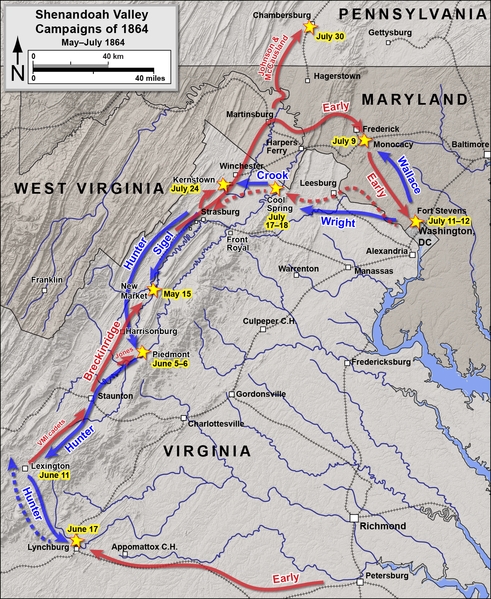
|
| Lynchburg Campaign Map |
| Battle of Piedmont History |
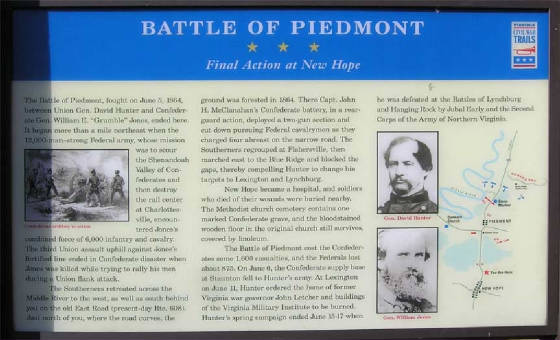
|
| Civil War Battle of Piedmont, Virginia |
Battle: After spending a rainy night encamped on the southern
outskirts of Port Republic, Hunter's army marched southward on the Staunton Road toward Mount Meridian through the morning
mist. Maj. Gen. Julius Stahel's cavalry led the advance, driving back Imboden's outposts. When Stahel's advance regiment reached
Mount Meridian, Imboden successfully counterattacked with the 18th Virginia Cavalry. Stahel fed reinforcements into the fight
and quickly overwhelmed the Virginians. Imboden barely escaped capture and only the timely charge from balance of his brigade,
which included local reserves, saved the 18th Virginia from disaster. The Confederates then fell back slowly toward the village
of Piedmont. Imboden expected to join forces with General Jones at Mowry's Hill but was surprised to find him at Piedmont.
Jones and Imboden debated the situation, but in the end Jones rank won the argument.
Jones advanced a battalion of dismounted cavalry, convalescents and detailed
men several hundred yards in front of his left wing, backed by a section of horse artillery, and Stahel's advance was stopped.
Jones deployed his two brigades of infantry (his left wing) along the edge of a woodlot that ran from the Staunton (or East)
Road to the high bluffs of the Middle River that anchored his left flank. He ordered Imboden to guard his extreme right flank
with the cavalry. On Imboden's immediate left, Brig. Gen. John C. Vaughn's brigade of dismounted Tennessee and Georgia horsemen
went into position. Vaughn's left flank rested six hundred yards to the rear of Jones' right wing, creating a gap in the center
of his line. There he positioned two batteries, including Captain Marquis's reserve artillery manned by 17-18 year-olds of
Augusta County.
| Battle of Piedmont Map |
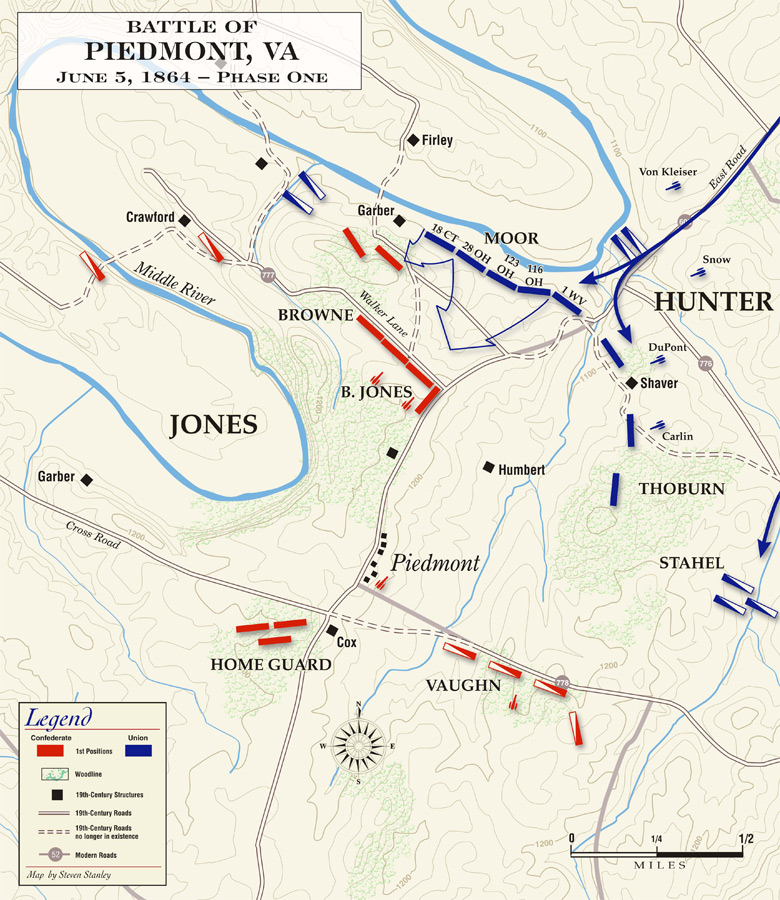
|
| Piedmont Battlefield Map |
Hunter's Chief of Staff, Colonel David Hunter Strother, described the battlefield:
"The enemy's position was strong and well chosen. It was on a conclave of wooded hills commanding an open valley between and
open, gentle slopes in front. On our right in advance of the village of Piedmont was a line of log and rail defenses very
advantageously located in the edge of a forest and just behind the rise of a smooth, open hill so that troops moving over
this hill could be mowed down by musketry from the works at short range and to prevent artillery from being used against them.
The left flank of this palisade rested on a steep and impracticable bluff sixty feet high and washed at its base by the Shenandoah
[Middle River]."
At noon, Hunter's infantry under the command of Brig. Gen. Jeremiah C. Sullivan
advanced. Colonel Augustus Moor's brigade drove in Jones' advance line on the west side of the Staunton (East) Road, halting
along the edge of a wooded lot opposite the one Jones' Confederates were stationed in. Sullivan ordered an advance but Jones
well protected infantry repulsed the effort. On the east side of the road, Colonel Joseph Thoburn's brigade advanced through
a wooded ravine toward Imboden's position under a heavy artillery fire. Thoburn withdrew to support the Union artillery when
he saw Moor's repulse. At this point, Captain Henry DuPont, the Union artillery commander, systematically silenced most of
the Confederate guns. Only a few guns with Imboden on the extreme Confederate right remained active. At this point, Jones
concluded to withdraw his left wing so that it was online with Vaughn and Imboden, but events soon changed his mind.
Sullivan reinforced Moor with two regiments and ordered another attack but
was again repulsed. This time the Confederates counterattacked but a stand by the 28th Ohio and some dismounted horsemen armed
with Spencer repeating carbines backed by a section of artillery forced the Southerners to fall back to their breastworks.
At this point, an emboldened Jones rearranged his forces to launch a concerted attack against Moor's battered brigade. Jones
ordered Vaughn to advance the greater part of his brigade to the left wing. The 60th Virginia Infantry moved from its position
in the edge of the woods covering the large gap in the center of his battle line. The Virginians ended up in a second line
of battle behind the main Confederate line, leaving the gap completely undefended.
| Hunter's Raid and Battle of Piedmont Map |
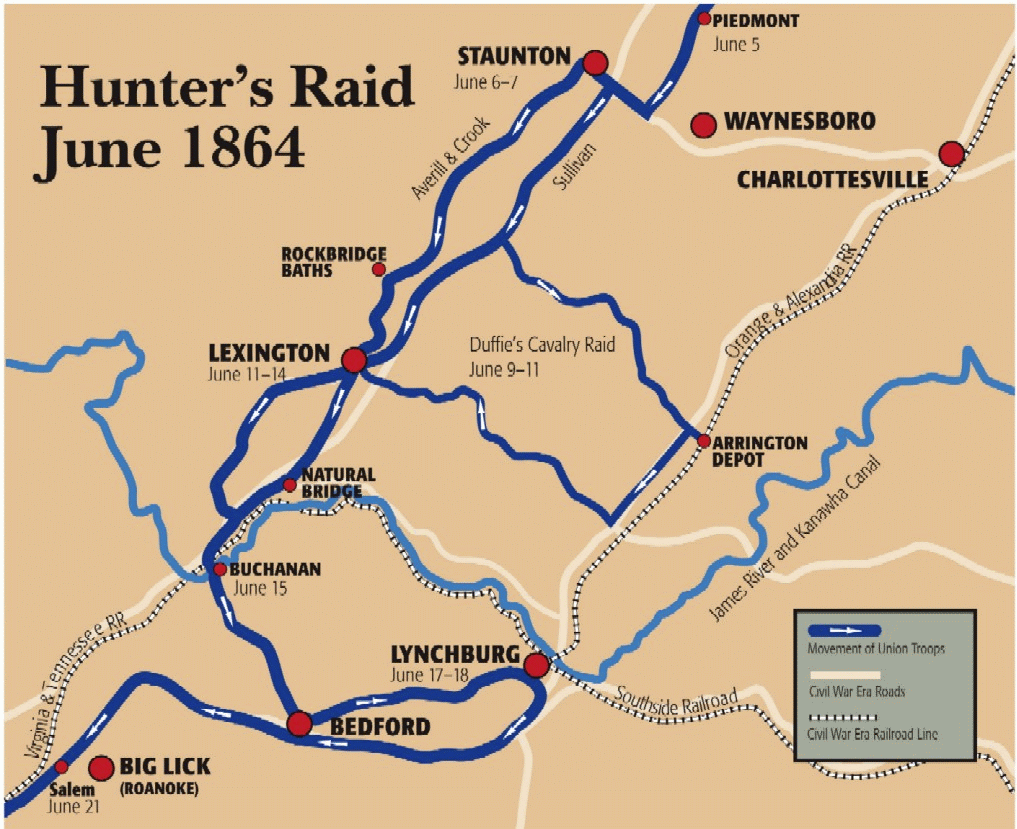
|
| Piedmont Civil War Battle Map |
Jones' concentration of troops against Moor's brigade did not go unnoticed.
The Federals spotted the gap on the right flank of Jones' left wing, and Hunter ordered Thoburn's brigade to attack the vulnerable
Confederate position. Thoburn quickly advanced to within a few yards of the Confederate left before his men were spotted and
shattered the Southern flank. At the same time, Moor's brigade joined the assault against the Confederate front. Jones attempted
to retrieve the situation bringing up the Valley Reserves who slowed Thoburn's advance but were unable to throw it back. Jones
dashed up to a small group of rallying Confederates and then charged toward the oncoming Union infantry. A Union bullet struck
him in the head, killing Jones instantly. The Union forces drove the Confederates toward the bluffs of the Middle River severing
the Confederate army in two halves. At the bluffs, the converging forces of Thoburn's and Moor's brigade, backed by some of
Stahel's Cavalry captured nearly 1,000 unwounded Confederates. Section of Captain John McClanahan's Virginia horse artillery
slowed the Union drive southward as it stood its ground near the village of Piedmont and barely evaded capture.
On the Staunton (East) Road, the 1st New York Veteran Cavalry launched a
vigorous pursuit of the beaten Confederates. However, another section of McClanahan's battery and elements of Vaughn's brigade
not sent to the left hastily deployed along the road between the villages of Piedmont and New Hope. When the New Yorkers chased
up the road after the fleeing Southerners, this Confederate rear guard opened fire devastating the Union cavalry and dampening
their enthusiasm for any further pursuit. Although at least 1,500 Confederates had been lost, the rear guard action at New
Hope allowed the remnants of the army to escape further damage. Vaughn learned that he was now the senior officer as a result
of Jones' death, but he was unfamiliar with the Shenandoah Valley and simply adopted Imboden's recommendations. Hunter's army
rounded up the prisoners and tended to the wounded at Piedmont, where the Army of the Shenandoah camped for the night, having
lost nearly 900 men killed and wounded. The next day, it became the first Union army to enter Staunton, Virginia during the
Civil War.
| Civil War Piedmont Battle Map |
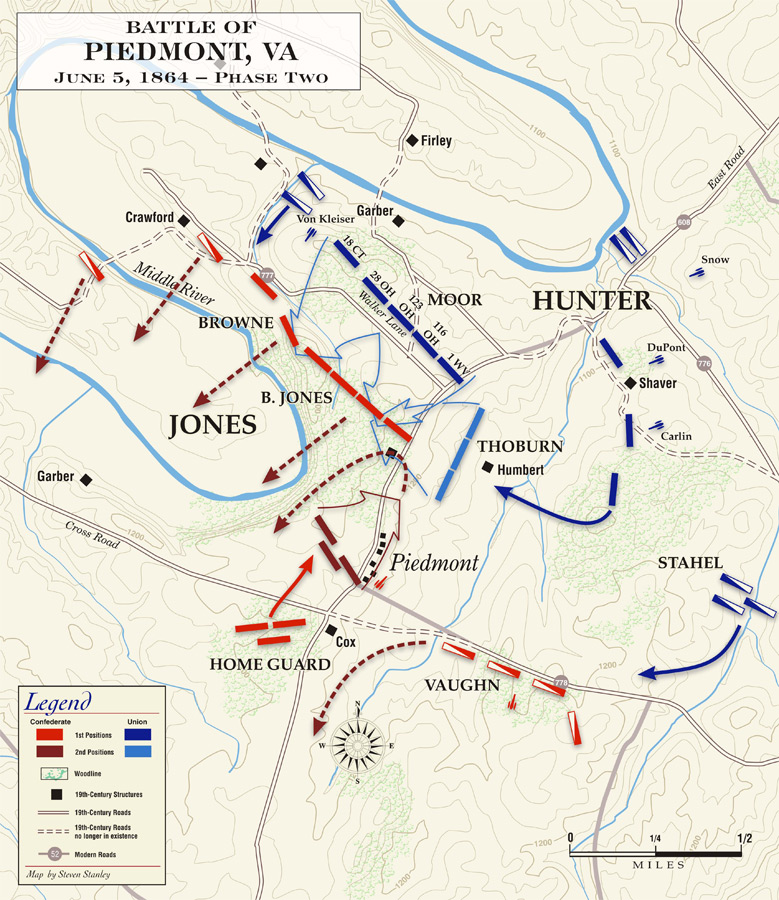
|
| Battle of Piedmont Battlefield Map |
Aftermath and Analysis: The Battle of Piedmont was
fought June 5, 1864, in the village of Piedmont, Augusta County, Virginia. Union Maj. Gen. David Hunter engaged Confederates
under Brig. Gen. William E. "Grumble" Jones north of Piedmont. After severe fighting, Jones was killed and the Confederates
were routed. Hunter occupied Staunton on June 6 and soon began to advance on Lynchburg, destroying military stores and public
property in his wake. Hunter, however, was foiled in his plan to destroy railroads, canals, and hospitals in Lynchburg
when initial units under Jubal A. Early arrived. Hunter, short on supplies, retreated back through West Virginia. (See Civil War Battle of Piedmont, Virginia: A History.)
During the Civil War, Augusta County served as an important agricultural
center as part of the "Breadbasket of the Confederacy." The Virginia Central Railroad ran through the county linking the Shenandoah
Valley to the Confederate capital at Richmond. One of the bloodiest engagements ever fought in the Shenandoah Valley took
place on June 5, 1864, at the Battle of Piedmont, a Union victory that allowed the Union Army to occupy Staunton and destroy
many of the facilities that supported the Confederate war effort. Augusta County suffered again during General Philip H. Sheridan's
"Burning", which destroyed many farms and killed virtually all of the farm animals. (Advance to Shenandoah Valley and the American Civil War.)
| Gen. William "Grumble" Jones |
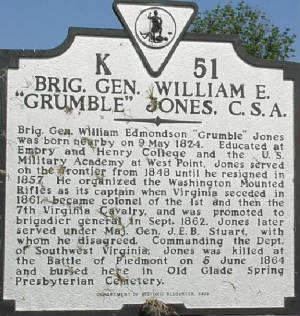
|
| Civil War Battle of Piedmont |
| Battle of Piedmont Aftermath |
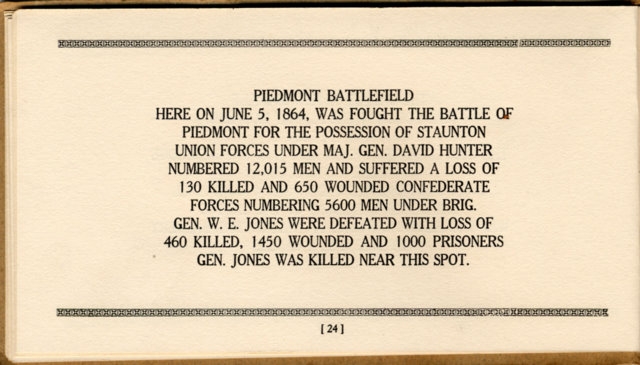
|
| Battle of Piedmont Results |
| Augusta County, Virginia, Map |
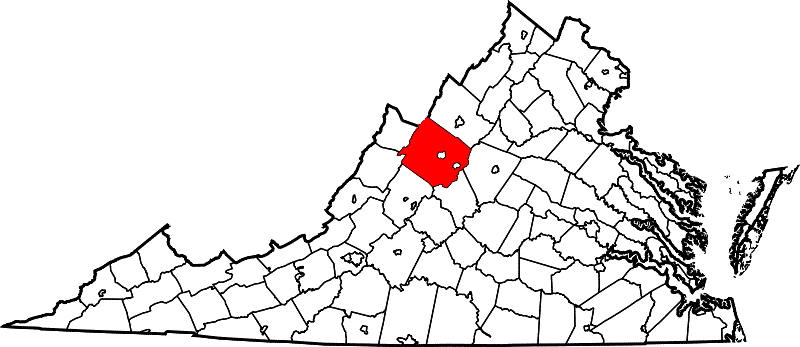
|
| Battle of Piedmont, VA. |
Confederate Army Order of Battle
Army of the Valley District
Department of Southwest Virginia
and East Tennessee
BG William E. Jones
|
Division |
Brigade |
Regiments
and Others |
|
Infantry
|
1st Brigade
Col Beuhring H. Jones
|
- 36th Virginia: Ltc William E. Fife
- 60th Virginia: Cpt James W. Johnston
- 45th Virginia Battalion: Ltc Henry Beckley
|
|
2nd Brigade
Col William E. Browne
|
- Thomas Legion (North Carolina): Col Robert Love
- 45th Virginia: Ltc Alexander Davis
- Virginia Cavalry (dismounted, from W.E. Jones' Brigade):
Maj R. Henry Brewer
|
|
Vaughn's Brigade
BG John C. Vaughn
|
- 16th Georgia Cavalry Battalion:
- 1st Tennessee Cavalry: Col James Carter
- 12th Tennessee Cavalry Battalion: Maj George W. Day
- 16th Tennessee Cavalry Battalion:
- 3rd Tennessee Mounted Infantry (detachment):
- 39th Tennessee Mounted Infantry (detachment): Maj Robert
McFarland
- 43rd Tennessee Mounted Infantry: Ltc David Key
- 59th Tennessee Mounted Infantry: Col William L. Eakin
- 60th, 61st & 62nd Tennessee Mounted Infantry (fragments):
|
|
Cavalry
|
Imboden's Brigade
BG John D. Imboden |
- 18th Virginia Cavalry: Col George W. Imboden
- 23rd Virginia Cavalry: Col Robert White
- Davis Maryland Battalion (includes two companies of
Rockingham County Reserves): Cpt Thomas S. Davis
- Augusta Mounted Reserves (2 companies): Cpt John Opie
|
|
Reserves
|
Harper's Valley Reserves
Col Kenton Harper |
|
|
Artillery
|
|
- Lewisburg Battery: Cpt Thomas Bryan
- Staunton Horse Artillery: Cpt John McClanahan
- Augusta Reserve Battery: Cpt James C. Marquis
|
Union Army Order of Battle
Army of the Shenandoah
Department of West Virginia
MG David Hunter
|
Division |
Brigade |
Regiments
and Others |
|
Infantry
BG Jeremiah C. Sullivan |
1st Brigade
Col Augustus Moor
|
- 18th Connecticut: Col William G. Ely
- 5th New York Heavy Artillery: Ltc Edward Murray
- 28th Ohio: Ltc Gottfried
Becker
- 116th Ohio: Col James Washburn
- 123rd Ohio:
Col William T. Wilson
|
|
2nd Brigade
Col Joseph Thoburn
|
- 2nd Maryland Eastern Shore: Col Robert S. Rodgers
- 34th Massachusetts: Col George D. Wells
- 54th Pennsylvania: Col Jacob Campbell
- 1st West Virginia: Ltc Jacob Weddle
- 4th West Virginia (detachment): Ltc James Dayton
- 12th West Virginia: Col William B. Curtis
|
|
Cavalry
MG Julius Stahel |
1st Brigade
Col Andrew McReynolds |
- 1st New York (Lincoln) Cavalry: Maj Timothy Quinn
- 1st New York Veteran Cavalry: Ltc John S. Platner
- 21st New York Cavalry: Col William B. Tibbits
- 2nd Maryland, Potomac Home Brigade: Maj Robert S. Mooney
|
|
2nd Brigade
Col John Wynkoop |
- 15th New York Cavalry: Cpt Oscar R. Colgrove
- 20th Pennsylvania: Ltc Gabriel Middleton
- 22nd Pennsylvania (Ringgold Battalion) (detachment):
Maj Henry Meyers
|
|
Horse Artillery |
- Battery G, 1st West Virginia Light Artillery (1 section):
Lt Samuel Shearer
|
|
Artillery
Cpt Henry A. du Pont |
|
- Battery B, 1st Maryland Light Artillery: Cpt Alonzo
Snow
- 30th New York Independent Battery: Cpt Alfred Von Kleiser
- Battery D, 1st West Virginia Light Artillery: Cpt John
Carlin
- Battery B, 5th United States Artillery: Lt Charles Holman
|
(Sources and related reading below.)
Recommended Reading: The
Shenandoah Valley Campaign of 1864 (McFarland & Company). Description: A significant part of the Civil War was fought in the Shenandoah Valley of Virginia,
especially in 1864. Books and articles have been written about the fighting that took place there, but they generally cover
only a small period of time and focus on a particular battle or campaign. Continued below.
This work covers
the entire year of 1864 so that readers can clearly see how one event led to another in the Shenandoah Valley and turned once-peaceful
garden spots into gory battlefields. It tells the stories of the great leaders, ordinary men, innocent civilians, and armies
large and small taking part in battles at New Market, Chambersburg, Winchester, Fisher’s
Hill and Cedar Creek, but it primarily tells the stories of the soldiers, Union and Confederate,
who were willing to risk their lives for their beliefs. The author has made extensive use of memoirs, letters and reports
written by the soldiers of both sides who fought in the Shenandoah Valley in 1864.
Advance to:
Recommended Reading:
The Shenandoah Valley Campaign of 1864 (Military Campaigns of the Civil War)
(416 pages) (The University of North Carolina Press). Description: The 1864 Shenandoah Valley Campaign is generally regarded as one of the most important
Civil War campaigns; it lasted more than four arduous months and claimed more than 25,000 casualties. The massive armies of
Generals Philip H. Sheridan and Jubal A. Early had contended for immense stakes... Beyond the agricultural bounty and the
boost in morale to be gained with its numerous battles, events in the Valley would affect Abraham Lincoln's chances for reelection
in November 1864. Continued below...
The eleven
essays in this volume reexamine common assumptions about the campaign, its major figures, and its significance. Taking advantage
of the most recent scholarship and a wide range of primary sources, contributors examine strategy and tactics, the performances
of key commanders on each side, the campaign's political repercussions, and the experiences of civilians caught in the path
of the armies. The authors do not always agree with one another, but, taken together, their essays highlight important connections
between the home front and the battlefield, as well as ways in which military affairs, civilian experiences, and politics
played off one another during the campaign.
Recommended
Reading: Lee's Endangered Left: The Civil War In Western Virginia, Spring Of 1864. From Kirkus Reviews: A competent, well-executed addition to the
ever-growing horde of Civil War literature, by Duncan (History/Georgetown University). The author reconsiders Union General
Ulysses S. Grants attempts to destroy the Confederates, led by General Robert E. Lee, at their traditional stronghold in western
Virginia and his efforts to threaten Lynchburg
during the spring and summer of 1864. Continued below…
The writing
here is crisp; refreshingly, our chronicler pays sharp attention to the effects of the campaign on civilians as the Union
army penetrated beyond its supply lines and came to live off the countryside in one of the Confederacy’s richest agricultural
regions, bringing home the harsh realities of war to civilians. The campaign swung back and forth, with Northern victories
at Cloyd's Mountain and New
River Bridge and Confederate routs at New Market, followed by a Union
failure to seize Lynchburg. Though the campaign proved costly
to the South, overall the Unions hope to capture the Shenandoah Valley foundered and the Confederates then went on to threaten
Washington, D.C. Duncan sensitively employs a wide variety of sources, military and civilian, to add to the coherence of his
account. Still, the books scope remains narrow, focusing on a not terribly glamorous period in the wars history; then, too,
wed do well to have the volume trimmed by a third. Duncan’s contention that the Unions
severity in dealing with civilian populations was directly reciprocated when the Confederates took Chambersburg,
Penn., creating a chain of vengeance that culminated when Sherman marched through the South, is insightfully argued, offering a fresh analysis to the
historical debate. Casual readers of the Civil War genre (and many die-hard buffs, as well) may want to leave this superbly
researched yet ultimately too specialized study for the historians to ponder. Includes 20 photographs.
Recommended
Reading: From Winchester
to Cedar Creek: The Shenandoah Campaign of 1864. Amazon.com Review: Virginia's Shenandoah Valley
was a crucial avenue for Confederate armies intending to invade Northern states during the Civil War. Running southwest to
northeast, it "pointed, like a giant's lance, at the Union's heart, Washington,
D.C.," writes Jeffry Wert. It was also "the granary of the Confederacy," supplying
the food for much of Virginia. Both sides long understood
its strategic importance, but not until the fall of 1864 did Union troops led by Napoleon-sized cavalry General Phil Sheridan
(5'3", 120 lbs.) finally seize it for good. He defeated Confederate General Jubal Early at four key battles that autumn. Continued
below…
In addition
to a narrative of the campaign (featuring dozens of characters, including General George Custer and future president Rutherford
B. Hayes), this book is a study of command. Both Sheridan and Early were capable military leaders, though
each had flaws. Sheridan tended to make mistakes before battles,
Early during them. Wert considers Early the better general, but admits that few could match the real-time decision-making
and leadership skills of Sheridan once the bullets started
flying: "When Little Phil rode onto the battlefield, he entered his element." Early was a bold fighter, but lacked the skills
necessary to make up for his disadvantage in manpower. At Cedar Creek, the climactic battle of the 1864 Shenandoah campaign,
Early "executed a masterful offensive against a numerically superior opponent, only to watch it result in ruin." With more
Confederate troops on the scene, history might have been different. Wert relates the facts of what actually happened with
his customary clarity and insightful analysis.
Recommended
Reading: Shenandoah 1862: Stonewall Jackson's Valley Campaign, by Peter Cozzens (Civil War America)
(Hardcover). Description: In the spring of 1862, Federal troops under the command of General George B. McClellan launched
what was to be a coordinated, two-pronged attack on Richmond
in the hope of taking the Confederate capital and bringing a quick end to the Civil War. The Confederate high command tasked
Stonewall Jackson with diverting critical Union resources from this drive, a mission Jackson fulfilled by repeatedly defeating
much larger enemy forces. His victories elevated him to near iconic status in both the North and the South and signaled a
long war ahead. One of the most intriguing and storied episodes of the Civil War, the Valley Campaign has heretofore only
been related from the Confederate point of view. Continued below…
With Shenandoah
1862, Peter Cozzens dramatically and conclusively corrects this shortcoming, giving equal attention to both Union and Confederate perspectives.
Based on a multitude of primary sources, Cozzens's groundbreaking work offers new interpretations of the campaign and the
reasons for Jackson's success. Cozzens also demonstrates instances
in which the mythology that has come to shroud the campaign has masked errors on Jackson's
part. In addition, Shenandoah 1862 provides the first detailed appraisal of Union leadership in the Valley Campaign, with
some surprising conclusions. Moving seamlessly between tactical details and analysis of strategic significance, Cozzens presents
the first balanced, comprehensive account of a campaign that has long been romanticized but never fully understood. Includes
13 illustrations and 13 maps. About the Author: Peter Cozzens is an independent scholar and Foreign Service officer with the
U.S. Department of State. He is author or editor of nine highly acclaimed Civil War books, including The Darkest Days of the
War: The Battles of Iuka and Corinth (from the University
of North Carolina Press).
Recommended
Reading: Stonewall in the Valley: Thomas J. Stonewall Jackson's Shenandoah Valley Campaign, Spring 1862. Description: The Valley Campaign conducted by Maj. Gen. Thomas J. "Stonewall" Jackson has long fascinated
those interested in the American Civil War as well as general students of military history, all of whom still question exactly
what Jackson did in the Shenandoah in 1862 and how he did
it. Since Robert G. Tanner answered many questions in the first edition of Stonewall in the Valley in 1976, he has continued
to research the campaign. This edition offers new insights on the most significant moments of Stonewall's Shenandoah triumph.
Continued below…
About the Author:
Robert G. Tanner is a graduate of the Virginia Military Institute. Tanner is a native of Southern California, he now lives
and practices law in Atlanta, Georgia. He has studied and lectured
on the Shenandoah Valley Campaign for more than twenty-five years.
Recommended
Reading: Shenandoah Summer:
The 1864 Valley Campaign. Description:
Jubal A. Early’s disastrous battles in the Shenandoah Valley ultimately resulted in
his ignominious dismissal. But Early’s lesser-known summer campaign of 1864, between his raid on Washington and Phil
Sheridan’s renowned fall campaign, had a significant impact on the political and military landscape of the time. By
focusing on military tactics and battle history in uncovering the facts and events of these little-understood battles, Scott
C. Patchan offers a new perspective on Early’s contributions to the Confederate war effort—and to Union battle
plans and politicking. Patchan details the previously unexplored battles at Rutherford’s Farm and Kernstown (a pinnacle
of Confederate operations in the Shenandoah Valley) and examines the campaign’s influence
on President Lincoln’s reelection efforts. Continued below…
He also provides
insights into the personalities, careers, and roles in Shenandoah of Confederate General John C. Breckinridge, Union general
George Crook, and Union colonel James A. Mulligan, with his “fighting Irish” brigade from Chicago.
Finally, Patchan reconsiders the ever-colorful and controversial Early himself, whose importance in the Confederate military
pantheon this book at last makes clear. About the Author: Scott C. Patchan, a Civil War battlefield guide and historian, is
the author of Forgotten Fury: The Battle of Piedmont, Virginia, and a consultant and contributing writer for Shenandoah, 1862.
Review
"The author's
descriptions of the battles are very detailed, full or regimental level actions, and individual incidents. He bases the accounts
on commendable research in manuscript collections, newspapers, published memoirs and regimental histories, and secondary works.
The words of the participants, quoted often by the author, give the narrative an immediacy. . . . A very creditable account
of a neglected period."-Jeffry D. Wert, Civil War News (Jeffry D. Wert Civil War News 20070914)
"[Shenandoah
Summer] contains excellent diagrams and maps of every battle and is recommended reading for those who have a passion for books
on the Civil War."-Waterline (Waterline 20070831)
"The narrative
is interesting and readable, with chapters of a digestible length covering many of the battles of the campaign."-Curled Up
With a Good Book (Curled Up With a Good Book 20060815)
"Shenandoah
Summer provides readers with detailed combat action, colorful character portrayals, and sound strategic analysis. Patchan''s
book succeeds in reminding readers that there is still plenty to write about when it comes to the American Civil War."-John
Deppen, Blue & Grey Magazine (John Deppen Blue & Grey Magazine 20060508)
"Scott C. Patchan
has solidified his position as the leading authority of the 1864 Shenandoah Valley Campaign with his outstanding campaign
study, Shenandoah Summer. Mr. Patchan not only unearths this vital portion of the campaign, he has brought it back to life
with a crisp and suspenseful narrative. His impeccable scholarship, confident analyses, spellbinding battle scenes, and wonderful
character portraits will captivate even the most demanding readers. Shenandoah Summer is a must read for the Civil War aficionado
as well as for students and scholars of American military history."-Gary Ecelbarger, author of "We Are in for It!": The First
Battle of Kernstown, March 23, 1862 (Gary Ecelbarger 20060903)
"Scott Patchan
has given us a definitive account of the 1864 Valley Campaign. In clear prose and vivid detail, he weaves a spellbinding narrative
that bristles with detail but never loses sight of the big picture. This is a campaign narrative of the first order."-Gordon
C. Rhea, author of The Battle of the Wilderness: May 5-6, 1864 (Gordon C. Rhea )
"[Scott Patchan]
is a `boots-on-the-ground' historian, who works not just in archives but also in the sun and the rain and tall grass. Patchan's
mastery of the topography and the battlefields of the Valley is what sets him apart and, together with his deep research,
gives his analysis of the campaign an unimpeachable authority."-William J. Miller, author of Mapping for Stonewall and Great
Maps of the Civil War (William J. Miller)
Try the Search Engine for Related Studies: Civil War Battle of Piedmont History, American Civil War Pictures
Details Battle of Piedmont Battlefield Photograph, Picture, List of Killed Wounded Captured Lynchburg Campaign General William
E Jones David Hunter Union Confederate Army Totals
Sources: National Park Service; Official Records of the Union and Confederate
Armies; Memoirs of Lt. Col. William Williams Stringfield; shenandoahatwar.org; Patchan, Scott C., The Battle of Piedmont,
Virginia, Sgt. Kirkland's Press, Fredericksburg, 1996; Patchan, Scott C., "The Battle of Piedmont and Hunter's Raid on Staunton,"
The History Press, Charleston, SC, 2011; Johnson, Robert Underswood & Clarence Clough Buell (eds.). Battles and Leaders
of the Civil War Volume 4 (New York: The Century Company), 1884; Lepa, Jack H. The Shenandoah Valley Campaign of 1864 (Jefferson,
NC: McFarland & Co.), 2003. ISBN 0-7864-1644-0; Patchan, Scott C. Shenandoah Summer: The 1864 Valley Campaign (Lincoln,
NE: University of Nebraska Press), 2007. ISBN 0-8032-3754-5.
|

